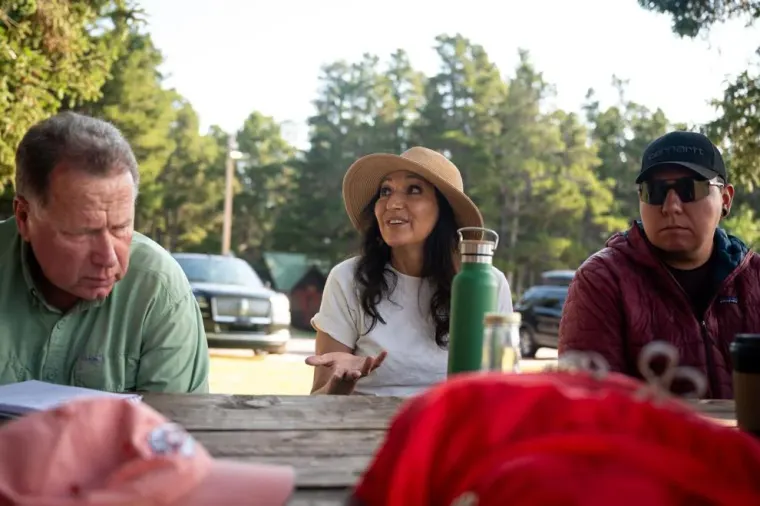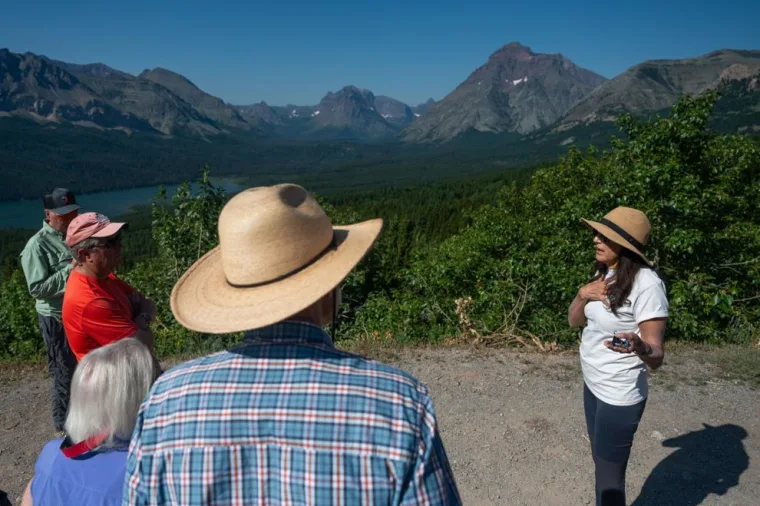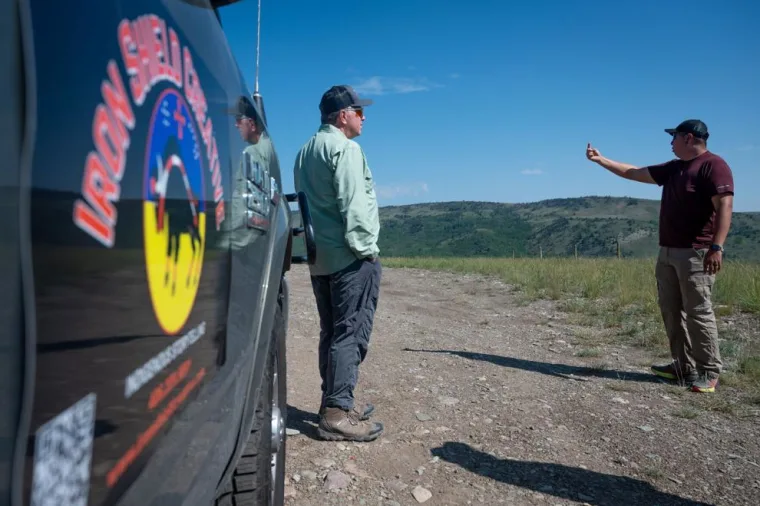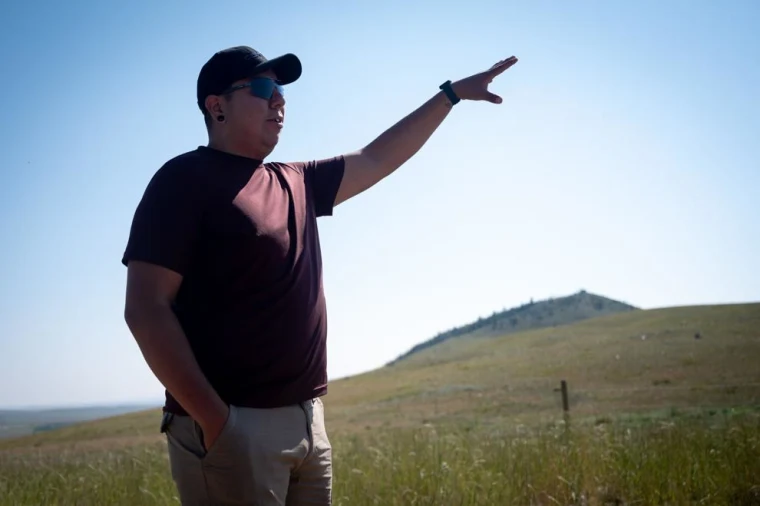Cultural hikes focus on teaching Blackfeet perseverance
A Blackfeet woman offers hikes with stories that teach about the tribe and its ties to the land
Nora Mabie
Missoulian

Ben Gallagher-Horn, left, takes a moment to enjoy the scenery and take photos of Divide Mountain, a natural landmark on the Blackfeet Nation which borders close to Glacier National Park. (Antonio Ibarra Olivares, Missoulian)
Lailani Upham stepped out of her truck and gazed at Lower Two Medicine Lake, which stretched beneath the towering Rocky Mountain Front.
“This is a ceremonial place for us,” she explained to her tour group, which consisted of two couples visiting from Kansas. “We’ve found some of our Blackfoot DNA here. It’s proof that we were here, that this was our homeland. Our stories tell us we were here.”
For Upham, the mission to educate non-Natives on Indigenous issues is personal. Growing up, she moved around and attended different schools in Havre and Harlem in north-central Montana. Despite the fact that Montana has 12 federally recognized tribes and seven reservations, she said, in school, she hardly remembers learning anything about Indigenous people.
A recent report found that 87 percent of U.S. schools don’t teach Native American history beyond 1900. The report alleges that because most Americans attended schools where information about Native Americans is “either completely absent … or relegated to brief mentions, negative information, or inaccurate stereotypes,” damaging narratives regarding Native people and Indigenous communities persist.
“As a kid, you don’t realize they’re not teaching about us,” Upham said. “It’s just the way life is.”

Upham joined the military later in life, and as a result, lived in places all over the country, including Alaska, Virginia, New Jersey, North Carolina, Georgia and Washington.
“I realized people in these places didn’t know much about us either,” she said. “Or, the things they did know were inaccurate or untrue. I felt like I was always educating, answering people’s questions. History in Montana does not include the Indigenous perspective. As a journalist and as an Indigenous woman, that bothered me.”
Now, years later, Upham, who has worked as a journalist, photojournalist and college professor, has embraced cultural education as her full-time job.
In 2021, she founded Iron Shield Creative, which offers Indigenous storytelling, education, consulting and media services. Through the company, she also leads cultural workshop hikes. The hikes, which can be scheduled on her website, ironshieldcreative.com, can occur just about anywhere in Montana and can be adapted for a group’s skill level, interest and ability. A full day hike, from 8:30 a.m. to 4 p.m., costs $225 per person, and a partial day, from 8:30 a.m. to 1 p.m., is $180. So far this year, she’s led at least eight different hikes and she has a handful more scheduled through September.
Upham hopes the hikes educate people on the Blackfeet ways of knowing, encourage visitors to connect with the natural world, help people gain a deeper appreciation for environmental justice and leave feeling motivated to stand behind tribes and support them in the issues they face.
“My heart has always been to tell our accurate stories,” she said. “So many books and movies are inaccurate, and I really feel it’s up to our people to really step up and share our stories.”

Two Medicine
Lower Two Medicine Lake lies within Glacier National Park, which borders the reservation and encompasses traditional Blackfeet homelands.
Because the Blackfeet Reservation is adjacent to Glacier National Park, thousands of visitors drive through the area each year. Ben Gallagher-Horn, Upham’s nephew and a member of the Iron Shield Creative team, said when people drive through town, they often make assumptions about the people who live there. Even old guide books furthered stereotypes, advising people not to stop in Browning.
“When you drive through Browning, people tend to just see poverty, trash, dysfunction,” he said. “There’s no understanding of why things are the way they are. There’s a reason for the things you see here. I’m trying to show that there’s a lot more here underneath the surface.”
Upham told the group that she wanted her tours to operate within the park, given the tribe’s history there, but said that leaders at Glacier National Park turned her down, saying they only contract with a select few companies. Upham said leaders at the park told her they partner exclusively with Glacier Guides for tours within the park. By contrast, Upham said Yellowstone National Park recently invited her to come host tours through her own company.
Representatives from Glacier National Park were not able to offer comment by deadline.
Mike Cillessen, one of the men on the tour, couldn’t believe it.
“What can be done to ensure you have access to the park?” he wondered aloud. He acknowledged that roads running through the reservation lead to Glacier and asked if the tribe could somehow leverage access to their roads to negotiate with the park.
“The council has talked about that,” said Gallagher-Horn. “But the roads are federally owned. So there are different jurisdictions here, like Bureau of Indian Affairs, Montana Highway Patrol and the FBI.”
It was just a glimpse of the red tape and bureaucracy the tribe must often deal with.

“People come here with good intentions,” Gallagher-Horn said. “But there’s a lack of understanding. I’m trying to convey the idea that we don’t need help. What we need is understanding and support.”
While the area now called Glacier National Park was once home to the Blackfeet, Upham said Glacier Park only contracts with one Blackfeet-owned company — Sun Tours. Ed DesRosier founded Sun Tours in 1992 with the vision to incorporate Native history in park tours.
While the park eventually allowed Sun Tours to operate within its boundaries in 1993, DesRosier said the process wasn’t easy. He remembers Glacier National Park officials initially turned him down, saying, as they did to Upham, that they have only a few company contracts. DesRosier said he was even cited several times for conducting tours in the park.
“So, we had a protest in front of a few different lodges,” he recalled. “And that really got their attention. It was not a good look for them.”
Eventually, DesRosier negotiated with the park’s regional office and was allowed access to the park. But 30 years later, DesRosier said Upham’s experience reminds him of his own.
“The process is highly regulated in the park,” he said. “But we need to reform those services to create more opportunity for entrepreneurs. The Blackfeet have treaty rights, and we border the park. The time for reform is now. These discussions have more merit now than ever before, as the parks try to co-manage with tribes.”
Red Blanket Hill
“This is Red Blanket Hill,” Upham told the group, as they made a second stop along Highway 49 on the western side of the reservation.
“Locally, this is known as not a good place,” Gallagher-Horn said.
Gallagher-Horn explained that Red Blanket and his band would ambush other bands at this site. Red Blanket is buried there, and Gallagher-Horn said in the community, it’s known that “unexplainable things” can happen on the hill.
He then pointed out different features across the highway.
“That’s Racine Basin,” he said, pointing to a hilly area to the west. “And that’s Home Gun Ridge. These places are named after Blackfeet families, and that comes from the Allotment Act.”
Also known as the Dawes Act, the legislation in 1887 authorized the president to allot portions of reservation land to individual tribal members. Individual allotments were to remain in trust for 25 years, and after that, the land would become fee title, which is taxed. The law also authorized the Interior secretary to negotiate with tribes to dispossess all “excess” land remaining after allotments — for the purpose of non-Native settlement. Through the act, the U.S. government ultimately sold more than 90 million acres of tribal land to non-Native citizens — dividing tribal land into a “checkerboard,” with some allotments reserved for non-Natives and some for Natives.

“The act was promoted as a way to make Natives ‘productive members of society, farmers,’” Gallagher-Horn said. “But really, the real agenda was to sell surplus land to non-Natives. And because tribes were under-resourced, a lot of people sold their land back to the state for pennies on the dollar.”
Throughout the tour, Gallagher-Horn spoke of several harmful U.S. policies, including Blood Quantum, the Termination Era and the Indian Relocation Act, among others. He stressed that each policy was created with the explicit goal of assimilation.
“When I was younger, I could tell us Natives were treated differently than white people,” he said. “I remember I hated being Native. I wanted to be white because I knew if I were white, I’d be accepted.”
Now, Gallagher-Horn takes pride in his Indigenous identity. For him, learning about history also reminds him of his tribe’s strength and resilience.
“I look at this stuff that we’ve been through, and I look at how we’re still here,” he told the group. “And that we’re growing exponentially.”

Divide Mountain
Gallagher-Horn and Upham got in the truck once more and drove up a winding and bumpy road to Divide Mountain on the western side of the reservation.
The group gathered in a circle at the top, as Upham and Gallagher-Horn spoke of the Bear River Massacre. Also called the Baker Massacre or Marias River Massacre, the attack occurred Jan. 23, 1870, when the U.S. 2nd Cavalry, led by Maj. Eugene Baker, killed at least 173 members of a friendly band of the Blackfeet Nation. Most of the victims were women and children. The gruesome event marked the end of the Blackfeet’s violent resistance against the federal government, and trauma persists today.
Gallagher-Horn and Upham are descendants of Chief HeavyRunner, who was killed in the massacre.
“For me, it still hurts,” Gallagher-Horn said. “I read the testimonials from survivors and I can’t help but cry. It’s not anger or bitterness. It’s just deep hurt. It’s trauma that’s inadvertently handed down generation after generation after generation, and you know, there’s no remorse or acknowledgment. Everyone on the reservation knows about the massacre, but when you leave, no one’s ever heard of it.”
To book a hike with Upham, visit Ironshieldcreative.com. The group also accepts last-minute bookings.
This article was first published in the Missoulian.






